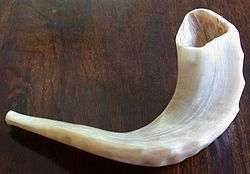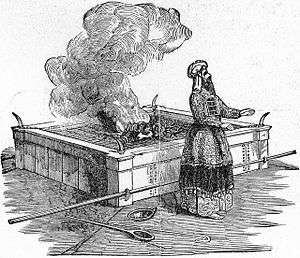Elul
Elul (Hebrew: אֱלוּל, Standard Elul, Tiberian ʾĔlûl) is the twelfth month of the Jewish civil year and the sixth month of the ecclesiastical year on the Hebrew calendar. It is a summer month of 29 days. Elul usually occurs in August–September on the Gregorian calendar.[1]
| ← Av Elul (אֱלוּל) Tishrei → | ||||
|---|---|---|---|---|
 An Ashkenazi shofar The shofar is blown every morning from the first day of Elul until Rosh Hashanah (except on Shabbat). | ||||
| Month number: | 6 | |||
| Number of days: | 29 | |||
| Season: | Summer | |||
| Gregorian equivalent: | August–September | |||
| Repentance in Judaism Teshuva "Return" |
|---|
|
Repentance, atonement and higher ascent in Judaism |
| In the Hebrew Bible |
 |
|
Altars · Korban Temple in Jerusalem Prophecy within the Temple |
| Aspects |
|
Confession · Atonement Love of God · Awe of God Mystical approach Ethical approach Meditation · Services Torah study Tzedakah · Mitzvot |
| In the Jewish calendar |
|
Month of Elul · Selichot Rosh Hashanah Shofar · Tashlikh Ten Days of Repentance Kapparot · Mikveh Yom Kippur Sukkot · Simchat Torah Ta'anit · Tisha B'Av Passover · The Omer Shavuot |
| In contemporary Judaism |
|
Baal Teshuva movement Jewish Renewal · Musar movement |
In the Jewish tradition, the month of Elul is a time of repentance in preparation for the High Holy Days of Rosh Hashanah and Yom Kippur. The word "Elul" is similar to the root of the verb "search" in Aramaic. Jewish sources from the 14th century and on write that the Hebrew word "Elul" can be understood to be an acronym for the phrase "Ani L'dodi V'dodi Li" – "I am my beloved's and my beloved is mine".[2] Elul is seen as a time to search one's heart and draw close to God in preparation for the coming Day of Judgement, Rosh Hashanah, and Day of Atonement, Yom Kippur.[3] Rabbi Shneur Zalman of Liadi compared, by way of analogy, the month of Elul to a king visiting his peasants in the field before returning to his palace.
During the month of Elul, there are a number of special rituals leading up to the High Holy Days. It is customary to blow the shofar every morning (except on Shabbat) from Rosh Hodesh Elul (the first day of the month) until the day before Rosh Hashanah. The blasts are meant to awaken one's spirits and inspire him to begin the soul searching which will prepare him for the High Holy Days. As part of this preparation, Elul is the time to begin the sometimes-difficult process of granting and asking for forgiveness.[3] It is also customary to recite Psalm 27 every day from Rosh Hodesh Elul through Hoshanah Rabbah on Sukkot (in Tishrei).
Aside from the blowing of the shofar, the other significant ritual practice during Elul is to recite selichot (special penitential prayers) either every morning before sunrise beginning on the Sunday immediately before Rosh Hashanah, or, if starting Sunday would not afford four days of selichot, then the Sunday one week prior (Ashkenazi tradition) or every morning during the entire month of Elul (Sephardi tradition). Ashkenazi Jews begin the recitation of selichot with a special service on Saturday night between solar mid-night (not 12:00) and morning light on the first day of Selichot.
Many Jews also visit the graves of loved ones throughout the month in order to remember and honor those people in our past who inspire us to live more fully in the future.
Another social custom is to begin or end all letters written during the month of Elul with wishes that the recipient have a good year. The standard blessing is "K'tiva VaHatima Tova" ("a good writing and sealing [of judgement]"), meaning that the person should be written and sealed in the Book of Life for a good year. Tradition teaches that on Rosh Hashanah, each person is written down for a good or a poor year, based on their actions in the previous one, and their sincere efforts at atoning for mistakes or harm. On Yom Kippur, that fate is "sealed."
Etymology
The name of the month Elul, like the names of the rest of the Hebrew calendar months, was brought from the Babylonian captivity, and originated from the Akkadian word for "Harvest". A similar month name was also used in Akkadian, in the form Elūlu. Eylül is also the name for September in Turkish; this is derived from Arabic: أيلول ʾAylūl, used in the Levant (see Arabic names of calendar months).
Elul in Jewish history
- 1 Elul – Moses ascends Mount Sinai for 3rd 40 days (1313 BCE)
- 1 Elul – The Prophet Haggai commands that the rebuilding of the Second Temple continue (520 BCE)
- 2 Elul – Shulchan Aruch published (1555)
- 3 Elul – Death of Abraham Isaac Kook (1935)
- 5 Elul – Ezekiel the prophet has a prophecy of the destruction of Solomon's Temple
- 10 Elul – Noah dispatches raven (2105 BCE)
- 12 Elul – Birth of Nachmanides (1294)
- 13 Elul – Death of Yosef Hayyim (1909)
- 17 Elul – Noah dispatches dove (2105 BCE)
- 18 Elul – Death of Judah Loew ben Bezalel (1609)
- 18 Elul – Birth of Baal Shem Tov (1698)
- 18 Elul – Birth of rabbi Shneur Zalman of Liadi (1745)
- 23 Elul – Dove brings olive Leaf to Noah (2105 BCE)
- 23 Elul – Death of Aleksander, Yitzchak Menachem Danziger, in Treblinka (1942)
- 24 Elul – Death of Israel Meir Kagan (1933)
- 25 Elul – The 1st day of the world according to the Genesis creation narrative (3761 BCE)
- 25 Elul – Jerusalem Walls Rebuilt (335 BCE)
- 25 Elul – Death of Eleazar b. Simeon, son of Simeon bar Yochai (2nd century CE)
- 25 Elul – Death of Shimon Peres (2016 CE)
- 27 Elul – Death of Sholom Rokeach (1855 CE)
- 29 Elul – Birth of Menachem Mendel Schneersohn (1789 CE)
References
- "Rosh Chodesh Elul / ראש חודש אלול". Retrieved 1 September 2019.
- "Shir Hashirim - Song of Songs - Chapter 6". Chabad.org. Retrieved 1 September 2019.
- Suissa, David (21 August 2013). "Love in the time of Elul". Jewish Journal. Retrieved 1 September 2019.
External links
- Dates of Elul
- Resources on the Month of Elul
- The month of Elul
- An in-depth discussion of the tradition of hearing shofar on Elul, plus meditations on the sound of shofar for each day of the month, can be found at The Shofar of Elul
- Jewels of Elul: A reading for each day of Elul from a diverse background of Jewish sources.